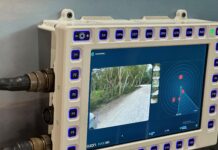After much anticipation and effort in Poland, Airbus (Eurofighter) and SAAB (Gripen-E) accepted the inevitable and much-feared conclusion: The Polish MOD chose the F-35 Joint Strike Fighter for their Harpia (Eagle) Fighter Acquisition Programme that includes the purchase of 32 multi-role fighter jets from the USA.
America in Central Europe
As evidenced across the region, the USA’s aerospace industry prevails where defence pundits might at least hope – if not expect – a European airframe would win this and other contracts. Instead, the USA continues to prove itself as an effective supplier to Central European defence forces at the NATO frontline: more than 40 F-16C / D to Poland; Bell helicopters for the Czech Republic; and, F-16s for the Slovak Republic and Bulgaria.
 The reported volume of U.S. business in Poland is US$ 4.6 billion, setting a higher contract value level for a single programme that EU-based companies have yet to match. When considering the Eurofighter is faster rate of climb, lighter frame with more wing area and has a greater range and service ceiling than the F-35, why is it – and arguably more expensive products from the USA – enjoying so much success in Central (and Northern) Europe?
The reported volume of U.S. business in Poland is US$ 4.6 billion, setting a higher contract value level for a single programme that EU-based companies have yet to match. When considering the Eurofighter is faster rate of climb, lighter frame with more wing area and has a greater range and service ceiling than the F-35, why is it – and arguably more expensive products from the USA – enjoying so much success in Central (and Northern) Europe?
While most “Airbus countries” tend to prefer their indigenous airframes, Eastern Europe remains a “different” case altogether when it comes to supporting local industry – if not being indifferent to taking advantage of the benefits of having an airframe in common with many of their closest Continental allies, namely, Germany, Italy and Austria.
Justified Rationale?
ESD discussed these interpretations and others with Central European senior military officers at a recent conference in Salzburg (Airpower Eastern Europe). The following observations reflect their thinking:
- The Eastern European countries are weaker than many of their continental allies and need a military partner they can wholly depend on if their national integrity is compromised (NATO Article-5).
- The Polish Air Force is desperate for at least a partial modernisation. By 2025 Poland will be Central Europe’s last operator of the powerful – yet obsolete – Russian Su-22M swing-wing strike-aircraft.
- The USA is the only NATO member Central Europe feels can rely on in the event of a concrete threat or escalation from Russia.
- The consensus is that buying from the USA ensures they will benefit from the USA’s military support. Yes, this is something of a long-standing quid pro quo of U.S. foreign Policy for decades.
- There are no off-set deals included in this acquisition programme; such a provision would raise total costs by more than an additional US$1 billion.
- The Obama Whitehouse agreed in late 2016 to send at least 1,000 US troops to Poland as warning to Russia.
- Now, Poland wants to quarter an entire U.S. Army tank division there and would pay $ 2 billion for this base, which is now being dubbed “Fort Trump” before any agreement is concluded. Calling the base “Fort Trump” as Poland intends will certainly ensure the USA’s “Egoist in Chief” approves the plan.
Seven Points to Remember for Poland
Regardless of fears and politics that influence decisions to “Buy American”, the F-35 is considered to be an exceptional multi-role aircraft. Here are seven things to remember about Poland’s F-35-acquisition under its Harpia Programme:
- Amount and Price – 32 x F-35As and the cost per aircraft is $87.3 million
- Avionics – the Block-4 will be current only until 2024 (Block 5 available in mid-2020s);
- Deliveries – beginning in 2024 with 6 fighter jets*, these will land in Poland in late 2025 and the last delivery will be in 2030; about four to six aircraft deliveries per year:
- Parts – one spare-engine;
- Training – Crew training package in the U.S., with 24 pilots and 90 technicians; so the first six F-35 remain in the USA until late 2025. This package includes eight Full-Mission simulators
- Extras – similar to the Norwegian F-35s the Polish tranche will come with a braking parachute as well
- Logistics – Lockheed Martin provides a logistical package until 2030.
* IOC targeted for 2028, after taking over a minimum of 8 aircraft and the return of all 114 personnel.
F-35 Variants and Suitability
Despite the controversy around its development (ballooning costs, partisan politics, over-wrought complexities), the Lockheed Martin F-35 or “Lightning II” has been an international success to date. The F-35 is a family of single-seat, single-engine, all-weather, stealth, multi-role combat aircraft.
It was specifically designed for ground-attack and air-superiority missions. The aircraft was developed and is built by Lockheed Martin and subcontractors, including: Northrop Grumman, Pratt & Whitney, and BAE Systems. The F-35 has three main variants: a) the F-35A is the conventional take-off and landing – or, CTOL – variant ideally suited to the U.S. Air Force’s missions; b) the F-35B is the short take-off and vertical-landing variant – or STOVL – favoured by U.S. Marine pilots as a replacement for the aged Harrier jump jets; and, c) the F-35C ideal for the U.S. Navy as a carrier-based – or CV – variant. As proof of its reliability and faith-in-product, the U.S. plans to buy 2,663 F-35s through 2037. In essence, the F-35 will comprise the bulk of the crewed tactical airpower of the U.S. Air Force, Navy, and Marine Corps for several decades. The aircraft are projected to operate until 2070.
Georg Mader











